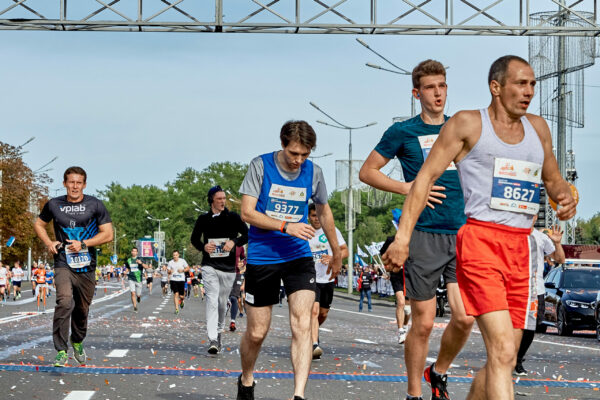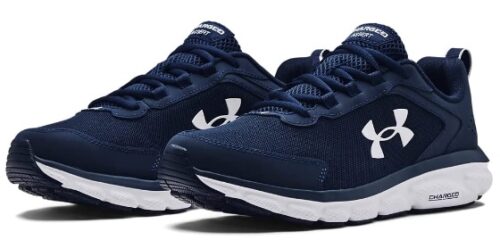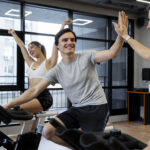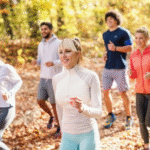If you search on google with search terms like “running calendar 2023” or similar in your country with your own language, it’s pretty certain that you can find an annual running event calendar. Then you can choose a race that suits you in either your current shape or the one you want to have for your chosen race in the future. There is a myriad of exciting races you can sign up for. In how to start running for beginners the easy way you’ll see that whether you are experienced or a beginner, there are a number of considerations you should keep in mind up to a race, so you show up well prepared and get a good experience.

How To Start Running –Your Motivation?
There can be many and very different motives for running but most often there are the very ambitious runners, and then the more social “super joggers” who enjoy the community and the fun. Training for a race is therefore about your individual preconditions and goal.
The reason why it’s a good idea to set a goal of participating in a race is that you give your running project a priority in your life. You have made a decision, you know what it means for you and what you want to do about it – like getting in shape by following a running program and completing a 5k race on date xx.xx.2022. When you reach your goal, you are in shape!
The marathon runner will complete a very long and ambitious training up to the race with primarily long slow runs (LSD). The jogger with several years of running experience exercises less and with other purposes.
Many of us can e.g. show up for the annual DHL Relay Race of 5 km as part of a “5 man colleague team” and just complete with relatively short preparation, where the finish time doesn’t really matter. But the beginner who wants to run the entire distance at a steady pace without walking at all should have some general basic principles in place before the start of a new training course.
Basically, good preparation is about ensuring both a good running experience, but also preparing the body to avoid running injuries.
The pandemic has got less impact. Today we have better prevention and effective covid-19 vaccines! Starting a running project will make you stronger and healthier than ever before. Wouldn’t that be a boost for your motivation and comeback story after the covid-19 pandemic?
Running Start – Find The Joy
Everyone – including you – can find joy in running, as long as you start from your current level and plan your running project based on that. Don’t plan based on the level you wish you were at. A running program based on where you are now and following the supercompensation principle is the best start.
Set aside time, for example, on the weekend to assess your preconditions to get started, and then plan your next training week based on them. How fit are you – your shape today? And when do you have time to run? Then you can find a 5k running program that fits your running level here.

How To Avoid The Classic Running Injuries
In general, as a new runner, you should keep in mind that your fitness during training quickly improves. This means that many runners tend to increase the running volume and distance quickly. We simply turn up too much for both the volume and intensity of our training in relation to the body’s ability to keep up.
Awareness points
You need to be aware that especially the body’s tendon tissues and bones need a much longer time to increase strength than muscle tissues. In just 3-4 weeks, an increase in muscle strength can be measured. It takes months for tendon tissue and bone to develop and achieve the same level.
If there is no balance between this and the training, especially beginners experience pain different places in the body e.g. in the Achilles and arch tendon under the foot or develop a so-called “runner’s knee”. By getting an injury like this, they might make the erroneous conclusion that running is not for me or that my body cannot handle it!
Beginner Goals
Try to set a goal of getting out to run 2-3 times a week so that you get some continuity into your training. It should preferably not take so long between each training session that you almost feel like you are starting over every time you have to run.
It gets too boring in the long run, and there is also no progression in the course (Supercompensation). Decide to lace up your running shoes tomorrow. A run on a Monday morning, which is often the hardest day of the week, will surely give you a sense of success.

How To Use Cross-Training as Variation
As a beginner, there is a good basic rule if you want to run a reasonable 5k race, a distance which for many beginners is an introduction to the world of road racing. You should use the time it takes of training for the race. If you never have exercised before, it takes longer than for someone who has experience from another sport such as soccer.
In addition, it is important to keep in mind that running naturally takes up a large part of the training. But strength training of legs and aerobic exercises as on ex. the Elliptical trainer (cross-trainer) is just as important complementary elements to running a good race.
With a combination of running and strength training also called cross-training in ex. a fitness center you’ll strengthen your legs as the running distance increases, and thus get variation in the training. This provides a versatile (different) impact on the body’s tendons, joints and muscles. In practice, you don’t receive the shocks every time you land as by running on roads. You also recruit several different muscle groups and load the legs in another way that reduces the risk of injuries.
Choose the Right Running Shoes
Running shoes are often a relatively expensive investment but they are also the runner’s best and most important equipment. There are many attitudes and theories surrounding running shoes, and it can sometimes be a jungle to find the right shoes for your purpose.
As a start you should choose, a running shoe with cushioning support throughout the foot midsole meaning not only in the heel area for when you land but also in the forefoot. You should feel that it fits well on the foot, and are comfortable.
The size of the shoe should usually be a little larger than your regular shoes, as there must be room for the foot to move a little forward in the shoe during the race.
The choice of shoes depends on running experience, running volume, running surface, running goals, body biomechanics and the way you move during running – running style.
If you need new running shoes, you can talk to a specialist in the sports shop or a physiotherapist who can guide you on the optimal shoe for you.
Guide to New Running Shoes
- Find your old running shoes and your favorite running sock.
- Go to a sports shop or a specialty store.
- Share your ambitions and running goals with the clerk.
- Show the wear pattern below the sole on your old running shoes.
- Choose the shoe that feels best and fits your run.
- Leave the store with a smile on your face and a desire to try a ride in your new running shoes.
- Run slowly in the new shoes and feel the body’s signals along the way – especially on the first ‘trial’ runs.
Under Armour Men’s Charged Assert 9 Running Shoe
How To Find Your Running Style
When I became an event supporter at some of the big running events and stood along the running route during the race and observed. I became aware that if I look at 100 runners passing by, I will also see 100 different kinds of ways to run? In general, there are some basic rules about running style, such as number of steps per minute (cadence), running economy, starting, landing, “heavy” running, pace, etc. Your running style after a test shows i.a. the best match for your choice of running shoe.
If you want more with your run, or you experience being hit by small injuries all the time, you can have an individual running style analysis done in, for example, your local area. In Google, you can type in ” running style analysis in your town here“! or just start reading about it here. Physiotherapists specializing in running will also be able to guide you in terms of getting the optimal running style and training.
Interval Training For Beginners

Interval training for runners is running at high intensity, where we try to improve the body’s ability to absorb and transport oxygen. We want to strengthen our oxygen uptake rate, as it has a direct impact on our fitness, which tells us something about how fit we are – our fitness status.
The best way to improve fitness is by practicing interval training, where you constantly change heart rate zone from high heart rate to low heart rate which means swinging from periods of high-intensity runs during the work periods followed by breaks during the rest periods.
There are many good running programs for this. We can especially recommend 10, 20, 30 interval running and if possible downloading the app 10,20,30, which is a good tool to get started with interval training.
How To Keep Up Your Motivation While Running
It’s easier said than done not to think of your run as a duty from time to time. It doesn’t help to try smiling when you lace up your running shoes if you suffer from the inside. Instead of forcing yourself to look forward to something that you don’t really like, you can instead work on finding the joy of running.
You can make some mental tricks as shown below:
- Listen to a podcast while running.
- Make a playlist with your favorite tracks and listen to them in an area with less traffic.
- Vary your running route. If you run the same route all the time, it becomes too monotonous.
- You do not have to force yourself to run. If it feels completely unmanageable to get going, it might be better to practice an hour of yoga or similar exercises and then try again tomorrow.
- Find a stadium or a running track you can run on. It can give you the feeling of being a professional runner.
- Running out in nature. The time can feel shorter if you run in the woods or along the beach because there are new things to look at.
- Use the opportunity to watch TV in the gym while running on a treadmill and it is raining outside.
- Join a running team and you will experience the joy of running from others.
The Social Aspect As Beginner

It only takes a pair of shoes to run, but still, it can be really hard to get them on and get out to run. Therefore, make an appointment with a friend, because then it’s easier to be kept to the fire. In the world of psychology, it is called the Köhler effect when a person works harder in a group than when he is alone. If you run with a friend, however, there is a risk that the meditative effect, which also can be a desired effect of running, is slightly lost.
But you can alternate between running alone or with others. Running alone is a great way to spend some time alone. When you run, you get rid of all frustrations and get peace of mind. The head feels so much lighter afterward and it affects everything in a positive direction.
The running buddy
By running with a friend or a group, you can have great benefits such as:
1. You get up from the couch and out the door
When someone is waiting for you, it is harder to skip training when the rain is pouring down and the sofa seems more attractive, because you are guaranteed to be confronted by your friend(s) afterward.
2. You get support
A hand on your back when running in demanding terrain, a few encouraging words when the route feels infinitely long, and a high five when you have finished the training. Support from your running buddy can motivate you and make you forget your frustration when the legs are getting tired and you really most want to turn around and get home.
3. You can push each other
There is a greater chance that the pace will be kept up as you’ll probably have it harder by admitting that you cannot keep up. Especially during interval training, it’s good to train with others, because it is more natural for you to run at max. pace when there are others to keep up with and you’re being pushed.
4. You can improve yourselves together
By comparing your running times, you can run longer and faster. According to a US study, there is some evidence that runners who compare their running data, particularly in virtual networks have a positive effect on their friends’ running performance.

The Time Up To Race Day
In the weeks up to a 5k or 10k race, you should not do anything different in your training than otherwise. The day before the race should be an “active” rest day where e.g. a smaller bike ride or swim would be ideal.
If you have to run a longer distance, you can consider your carbohydrate intake the week up to, which should be relatively high. However, this is not necessary for a 5-10-15 km race.
Good advice on the race day itself:
- Make sure you get a good night’s sleep.
- Eat a good breakfast 2-3 hours before the race
- Make sure you get a good fluid intake – for longer races
- Arrive well in advance
- Bring a good mood
For a half or full marathon distance, you should consider a supplemental intake of gel (or other energy supplements) in the race.
After the race

At the shorter 5k-10 k distances, the body does not need any further recovery in the days afterward. If you are an inexperienced runner, you may experience training soreness the next day, which is very normal.
However, no further measures are needed to “recover”. But “active recovery” such as an easy bike ride or swimming is good for increasing blood flow in the muscles and getting some of the stiffness in the legs away the next day.
Running is efficient and easy to implement on a busy day. In a relatively short training session, you can achieve a positive effect on heart and cardio system, and thus improve your overall health in combination with considerations about your diet.
It is a good idea for all runners, regardless of level, to: “Keep it simple” and use your common sense. In that way, you get far with your running and with your health.
I hope you get something out of this post. If you have any questions about the topic or want to leave your own Personal review, please leave a comment below.
[faq-schema id=”7480″]







Hello Henrik,
Awesome post about starting to run you have here. As of right now, I’m not a runner yet, but I would love to start working out and putting my running shoes on. However, as with many things in life, it’s just that first step. Getting off the couch and starting to run for the first time, seems like the most challenging thing ever. This post does help a lot. I’ve already ordered my running shoes and I have found a nice running event for beginners nearby.
Thanks for this article and the great tips.
Cheers,
Vince
Hi Vincent
Thanks for the comment. Happy that you find it useful. In the beginning, new habits can be challenging to acquire, as old habits still make demands. Wish you the best with your running project!
– Henrik
Thanks for a insightful article on running. You see I am not runner at all. I have tried to get into running but nope . However I find I rather run then walk to get somewhere fast and I burn more calories. Out of what is mentioned in this article I find listening to music to help me the best . That way it goes by quicker. With that said maybe one day I will enjoy running.
Hi Kiersti
Thank you for the comment. It’s always best to find your own way and be aware of it – as you are!
Be Well
First of all thank you so much for posting like this now. I also run a lot of the time. But sometimes my leg hurts. Today I found out the exact reasons for that. I have no beginner goal. I run one at a time. The other thing is to use runong shoes. I think that’s very important too. I hope you take this one I have recommended. Keep posting like this. Thank you very much.
Hi pasindu dimanka
Thank you for the comment. Yes, running shoes are the runner’s most important support tool!
Be Well